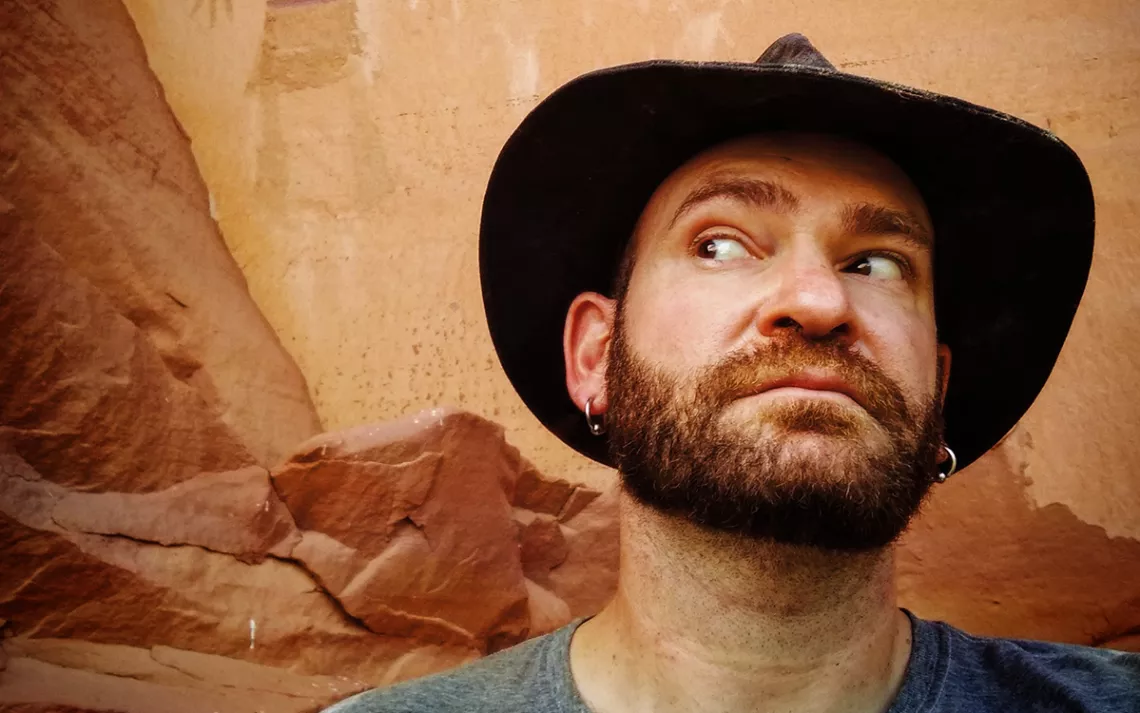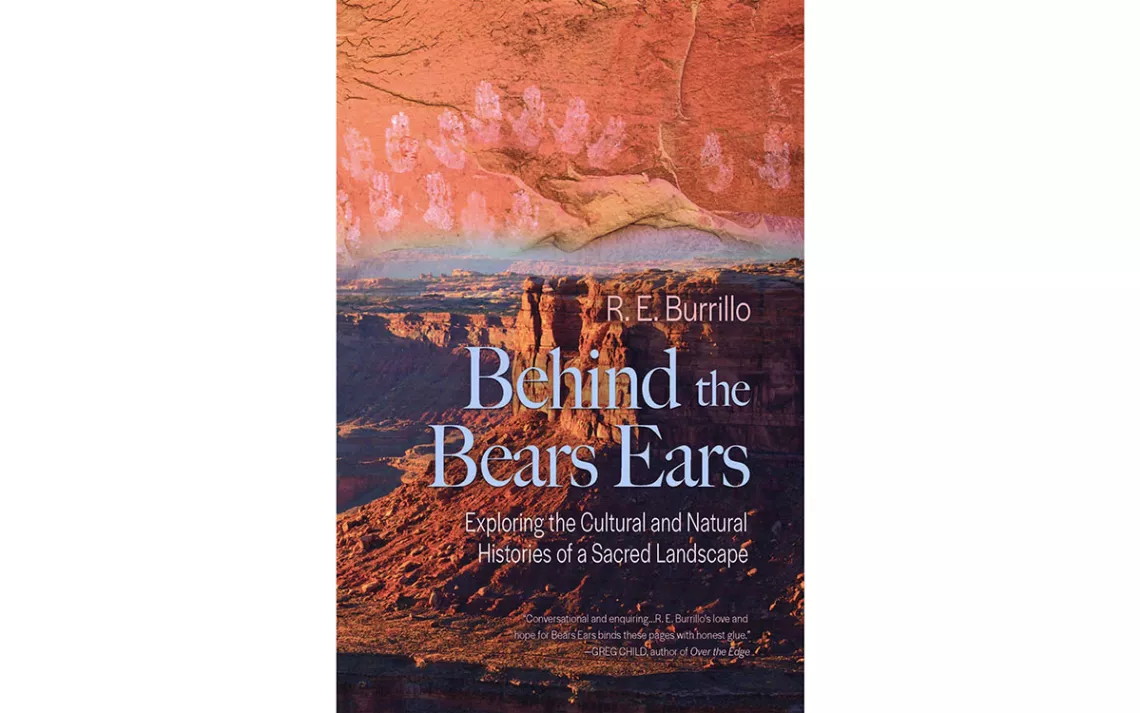Paying Bears Ears Its Karmic Debt
An interview with R.E. Burrillo, author of "Behind the Bears Ears"

Photo courtesy of R.E. Burrillo
Since 2010, archaeologist R.E. Burrillo has been deeply entrenched—sometimes literally—in archaeological and conservation efforts in and around Bears Ears National Monument. When former president Donald Trump reduced the monument by 85 percent in December 2017, Burrillo's surveys, research, and reports became key components of lawsuits filed against the federal government.
Now, in Behind the Bears Ears, Burrillo intertwines his personal story with the complex cultural history of the area, examining the human history, Indigenous perspectives, archaeology, and politics of the 1.35-million-acre chunk of southeastern Utah that is at the heart of the debate over public lands in the US. Themes of “finding home” and “healing” launch compelling explorations into Bears Ears’ history. “By the time I got involved in research and conservation efforts in the Bears Ears area,” Burrillo explains, “I was paying off a rather sizable karmic debt that I felt I owed the place.” This book, along with Burrillo’s contributions to the ongoing lawsuits, is part of his penance.

Burrillo was encouraged to share his Bears Ears story by Regina Lopez-Whiteskunk, a Ute tribal leader and former co-chair of the Bears Ears Inter-Tribal Coalition who believes that everyone who “knows that place is deeply and invariably moved by it.” Lopez-Whiteskunk wrote the book’s touching foreword; here’s how she outlines Burrillo’s undertaking: “Braiding the knowledge of our ancestors, scientific data, and the process of our democracy (to) inspire our continued efforts to protect sacred, open spaces that we share.”
Burrillo accomplishes this with the accuracy and knowledge of a scientist while writing in an approachable, conversational (and often humorous) style. He emphasizes the need for archaeologists, public land managers, educators, and visitors to look toward Indigenous leadership from here on out. This includes critiquing his own work for describing “non-Western cultures, beliefs, and histories . . . almost entirely in Western terms.” His personal experiences guide readers into the canyons and across the mesas of Bears Ears. “Telling the human history of the place in such a way will lead the reader into a deeper understanding of why it is so important to so many people.”
In 2017, Burrillo and I serendipitously met in a Southwest coffee shop while we were both writing about Bears Ears. The two of us, still strangers, drove there the very next day for a hike. We’ve remained friends and collaborators ever since on numerous adventures, books, and articles. I learned that if you want to get ahold of Burrillo when he’s not working or writing, you’ll need to get your boots dirty, as almost every weekend he can be found hiking in some tortuous stretch of the Southwest desert. I often join him for such jaunts, and though this interview had to be conducted remotely, it should be read as if both of our brows were beaded with sweat, legs scratched by catclaw and cactus, and smiles painted across dirty faces.
Sierra: You talk about owing a debt to Bears Ears throughout the book. What is your personal outlook on your penance heading into the future?
R.E. Burrillo: I don't really know, to tell you the truth. The book is out, the lawsuits are filed, the future of Bears Ears is firmly in the hands of the tribes and the lawyers and politicians and advocacy groups. The book was really the synthesis of years of research conducted on behalf of agency and private-sector cultural resources interests: conservation groups like Friends of Cedar Mesa, Grand Canyon Trust, Utah Diné Bikeyah, and a few of my own little passion projects. I will always love the place and visit it and encourage others to keep it protected and respected. If the tribes or any of those groups asks me to get involved again, I will, but otherwise, that was my Bears Ears story.
How can readers give back to Bears Ears or similar places they love?
Inform yourself. Don't just go blustering into wilderness areas like you would a playground. Yes, please, definitely enjoy America's public lands for as long as they remain public, but do so in a manner that is most respectful and least damaging.
While there is no telling what will actually happen, what do you envision for Bears Ears National Monument with President Biden and Secretary of the Interior Haaland at the helm?
If I had to choose, and this may not be the most popular answer, but I would prefer the lawsuits run their course rather than the latest round of Antiquities Act ping-pong. If they restore or expand the monument using the Antiquities Act, it's just a continuation of the ongoing problem of how to interpret it.
There is a smidgeon of precedent with the Outer Continental Shelf Lands Act, in which a judge ruled that neither it nor the Antiquities Act gives a president the authority to undo previous actions taken under their aegis, and if it holds up on appeal, that'll at least be something. But a definitive “this was not legal” from the US court system would ensure that any successive presidents can't just keep the ball in the air any longer. Biden and Haaland’s efforts vis-à-vis the Antiquities Act would probably best be utilized in creating new national monuments, like Great Bend of the Gila or Greater Grand Canyon, and making sure that legislation includes tribal involvement—like it did at Bears Ears.
What are the biggest threats to the greater Bears Ears National Monument in the coming years?
Visitation is the threat. It's bigger than grazing, looting, or development on their own, and maybe bigger than they are combined. The latest data from the BLM show that visitation to the Bears Ears area continues to rise at a nearly exponential rate. Most conservationists got on board with the monument because they hoped that even though it would attract even more visitors, it would also address the impacts (through, say, more and better signage, trail maintenance, and stabilization) so the total benefits would still outweigh the total costs. The worst-case scenario was the designation of a monument, which effectively advertises it to the world, followed by a change in leadership to an administration that would cut the agencies' ability to respond to impacts even further—and that's exactly what happened. The crowds keep coming, the damages keep mounting, and most of the headlines still focus on either the politics of the issue or the real-but-much-smaller problem of looting. Visitor management should be the topmost priority going forward.
Your book emphasizes the need for the field of archaeology to shift to Indigenous leadership. What is the outlook on this according to Indigenous archaeologists you work with?
Most of the Indigenous archaeologists I work with are cultural resource management personnel working for folks like PaleoWest, my current employer; I'm happy to report that there seems to be more Indigenous employees in the realm of CRM every year. I've always been particularly enamored with the anthropology program at Northern Arizona University. They have a number of tribal scholars and professors on staff, and their emphasis on applied paradigms and multivocality in the field is probably at the very top of the heap.
As for how the shift can occur, a lot of it comes down to funding. Louis Williams, a Diné fellow in Bluff, was recently able to launch his own Indigenous wilderness-guide service called Ancient Wayves after years of working for local Anglo guide services. My good friend and colleague Lyle Balenquah has gotten grants for his work, and he's spun much of that effort back out toward "spreading the knowledge" as he likes to put it. What I'd like to see is at least 40 percent of National Science Foundation dissertation grants for archaeological projects going to Indigenous scholars. That would be a good point to reach.
Behind the Bears Ears delves into your personal experience finding healing and connection in Bears Ears. What is it about Bears Ears that facilitates this?
I honestly don't know. I've spent a lot of time thinking about that, and I just end up facing the mystery over and over again. It could be timing—like I found it just when I was at the point in my life where I was seeking my "home." It could be that the many components of the place—the archaeology, the plants, the animals, the canyons, even the color of the rocks—forms a contour profile with which my own personality fits like the edge of a key. (Although that poetic perspective neatly overlooks all the many ways that it doesn’t.) So, I'm not really sure. I wish I could ask the place itself why it's been so damn good to me.
 The Magazine of The Sierra Club
The Magazine of The Sierra Club



